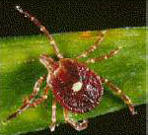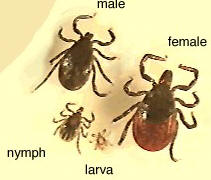|
Ticks are plentiful again
 Send a link to a friend
Send a link to a friend
By John
Fulton
[MAY 8, 2006]
Tick reports have been plentiful again this
year. Anyone who has been out in tall grass or wooded areas can
probably attest to that. Probably, the frequent spring rains in much
of the state have provided the high moisture and humidity that ticks
need. Ticks are large, flattened mites that feed as parasites on
mammals, birds and reptiles. They hatch from eggs into six-legged
larvae that locate hosts and feed before dropping off the host and
molting into eight-legged nymphs. Nymphs locate hosts, feed and drop
off to molt into eight-legged adults. Adults also locate hosts on
which to feed. Males may stay on the host, mating with females
coming there to feed. Females engorge on blood to several times
their original size, drop off the host and lay hundreds of eggs.
With each tick having to find three hosts in its lifetime, many
ticks starve before reproducing, although ticks can survive for long
periods without food.
|
|

American dog ticks
American dog ticks, commonly known as wood ticks, are the most
common in Illinois. They feed as larvae and nymphs on small
mammals, only attacking humans when the ticks reach the adult
stage. Adults are reddish-brown and three-sixteenths-inch long.
Females have a silver shield behind the head; males have silver,
wiggly lines down the back. These ticks transmit Rocky Mountain
spotted fever, a virus found here but most common in North
Carolina and nearby areas. In Illinois, they also carry
ehrlichiosis, producing symptoms similar to Lyme disease.

Lone star tick
Lone
star ticks feed on humans and other mammals as larvae, nymphs
and adults. Larvae and nymphs are commonly called seed ticks
because of their size. Walking through an area of newly hatched
larvae may result in hundreds attacking your legs. Adults are
about one-eighth inch in diameter, roundish and brown; females
have a white spot in the middle of the back.

Deer ticks
Black-legged ticks, including the deer tick subspecies, also
feed on people as larvae, nymphs and adults. Larvae are tiny,
about the size of the period at the end of a sentence; nymphs
are pinhead-sized. Both tend to migrate up the legs and feed in
the groin area. Adult black-legged ticks are teardrop-shaped,
reddish-brown and about one-eighth-inch long. The deer tick
subspecies is found mainly in the northern half of the United
States. Deer tick larvae feed on white-footed mice, picking up
the Lyme disease, which can be transmitted to people by the
nymph and adult ticks.
[to top of second column] |

Ticks are numerous in areas of tall grass, where humidity is high
and hosts common. Mowing greatly reduces tick numbers. When walking
or working in areas of tall grass or other areas with ticks, apply a
repellent containing about 30 percent DEET, such as Off or Cutters,
to the lower legs and pants legs. If ticks are numerous in mowed
areas, spraying carbaryl, permethrin or bifenthrin should help give
some control. If a tick is attached, grasp the head with tweezers
where the mouthparts enter the skin, pulling slowly and
consistently. The tick will release its mouthparts and come loose.
Do not handle the tick. Good luck trying to smash a tick. It's about
like trying to flatten a dime with a rubber mallet. Other methods
such as heat and nail polish commonly kill the tick, resulting in
locked mouthparts that remain in the wound to cause infection. A
tick typically feeds for 24 hours before releasing disease
organisms. Remove ticks promptly when you find them.
Also pay particular attention to pets in wooded areas or areas
with tall grass. Use preventive products when possible. Carbaryl
dust may be used on pets and their sleeping areas to help control
ticks and fleas.
[John
Fulton, unit leader,
University of Illinois Extension,
Logan County Unit]


 |